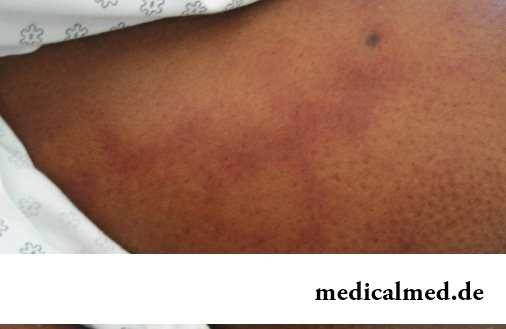





Strongyloidosis
General information about a disease

The strongyloidosis is a chronic disease which is shown by various pathologies of digestive tract. A contagium – the intestinal ugritsa (Strongyloides stercoralis) – was for the first time described by the French doctor Normand who allocated it from excrements of sick people in 1876. For the next decades the strongyloidosis was studied rather well, however, in recent years interest in this disease significantly increased because it often is found in the people suffering from AIDS.
Strongyloidosis source is always the person, more precisely than his excrements with which eggs get to external environment. In the soil of a larva hatch, and then pass to the new carrier through skin or by the use of the infected food stuffs. In either case parasites migrate in a stomach and intestines where females lay new eggs. As a rule, the analysis (the strongyloidosis rather precisely is determined by tests a calla) shows existence of activators in the field of lyuberkyunovy glands of a duodenum, but in the absence of treatment of a strongyloidosis of ugriyets occupies new territories and quite often it is found throughout a small intestine and even in peloric department of a stomach.
Strongyloidosis symptoms
As parasites are localized in the most different bodies and fabrics, clinical manifestations of a strongyloidosis are very various. However, within the first 2-3 weeks the disease has the hidden character and proceeds almost asymptomatically. The first alarming symptoms of a strongyloidosis are shown only after the termination of an incubation interval and keep for several years, and remissions can be replaced by sharp aggravations.
It is worth carrying to symptoms of a strongyloidosis:
- allergic reactions in the form of skin rashes and blisters of pinkish-red color;
- muscle and joints pains;
- increase in the blood sedimentation rate (BSR);
- increase in quantity of eosinophils in blood;
- abdominal pains;
- persistent diarrhea;
- yellowness of integuments and scleras (it is shown not always).
Skin rashes at a strongyloidosis keep for 2-3 days then disappear, without leaving any marks. At the diagnosis the strongyloidosis, symptoms on skin are shown several times a year that is connected with migration of parasites on circulatory system. During the aggravation periods patients complain of dizziness, sleep disorders, weakness. Sometimes the pulmonary pathologies caused by an exit of larvae in a gleam of bronchial tubes are added to these symptoms of a strongyloidosis.
When the disease passes into a chronic form, the clinical picture changes. Depending on the available manifestations doctors allocate several common forms of a strongyloidosis:
- the duadeno-cholecystis form of a strongyloidosis – differs in a slow current, the dull aching aches in right hypochondrium, nausea, vomiting, lack of appetite. At researches (X-ray, ultrasonography) deformations of a gall bladder are found;
- the gastrointestinal form of a strongyloidosis – is shown by strong indications of a digestive disturbance – long locks or, on the contrary, impetuous ponosa. In a chair impurity of blood and slime are observed. Language of patients is laid over;
- neuroallergic form of a strongyloidosis – on skin strongly pruritic rashes develop. They quickly disappear, but rashes succeed headaches, sleep disorders, irritability and weakness;
- pulmonary – the activator is localized in respiratory system and provokes various pulmonary diseases.
Despite abundance of forms, in medical practice the mixed strongyloidosis which symptoms combine the main defeats of all vital systems of an organism most often meets. The most strongly destructive processes are shown at people with the weakened immunity.
Strongyloidosis – treatment of a disease

As the main drugs are used минтезол (thiabendazole) and albendazole. The course of treatment of a strongyloidosis lasts several days then at the patient retests on a strongyloidosis for possible correction of process of recovery undertake. Symptomatic means are applied to stopping of the strongest symptoms of a disease.
Prevention of a strongyloidosis
Prevention of a strongyloidosis is directed to early identification of patients and counteraction to environmental pollution of a fekalyama. For disinfecting of fecal masses chloric lime is used. The soil is cleared by means of pesticide of a karbation and various fertilizers (phosphatic, nitric, potash). It is also necessary to observe personal hygiene. It is desirable to refuse circulation on the ground barefoot, needlessly not to contaminate skin the earth, to carefully wash vegetables, fruit and berries. For work on personal plots it is reasonable to use special gloves and to wash hands before meal.
Antidepressant Klomipramin causes an orgasm in 5% of patients.

History of use of an anesthesia during operations contains more than 160 years. Annually in the world hundreds of thousands surgical вм are carried out...
Section: Articles about health
The state of health of the person in many respects depends on chemical composition of biological liquids of an organism. Specialists consider that PH value of these solutions has to be in range of 7,35-7, 45. A deviation in the smaller party (so-called "acidulation") to a chra...
Section: Articles about health
So, you resolved to lose weight. And now you try to understand what to begin with: from exercise stresses or a diet? And how to make that process of weight loss did not give you an inconvenience, and, on the contrary, brought joy?...
Section: Slideshow
Work of a brain is extremely complex and in many respects is not studied yet. It is confirmed also by the features of thought processes which are shown in...
Section: Articles about health
Popular joke that there are no healthy people, and is nedoobsledovanny, most of us considers an honest truth, continually it is necessary to hear that all of us are sick hardly from a school bench. It is hard to say, whether so it actually because...
Section: Articles about health
Very often as a source of the infection which caused a disease serves our house - the place which a priori has to be safe. However disease-producing bacteria can perfectly feel not only in insanitary conditions, but also in our apartment if not to carry out due care of favourite places of their dwelling. What they − sources of their reproduction? Let's consider 10 most widespread places in our house, the most dangerous from the point of view of infection with microorganisms....
Section: Articles about health
Life expectancy in various regions of Earth is not identical. Exert impact on it social stability, economic бл...
Section: Articles about health
Women quite often suffer from complexes concerning the sizes of the bust. Strangely enough, not too modest, and excessively curvy shapes become the reason of sincere discomfort sometimes. Except psychological problems, a big bust sometimes with...
Section: Articles about health
Any of us is not insured from a heavy illness of the loved one. Happens and so that someone from family members becomes the bed patient, and remains in such state for a long time. It extremely suppresses both the most injured, and all its house which life considerably changes....
Section: Articles about health
Beauty shop – the place which is associated only with positive emotions: joy, pleasure, relaxation. One...
Section: Articles about health
Condition of lips (their morbidity, outward) – one of indicators of health of the person. The peeling, dryness, pallor, and also cracks in corners of a mouth can be not only the cosmetic shortcoming which arose owing to physical damages and weather having sent away...
Section: Articles about health
Some people consider what for medicine of the 21st century of secrets in the field of health of the person almost does not exist. It absolutely not so. The more answers scientists receive, the more the most difficult questions are raised for them by life. Besides, there are diseases which are not explained with science in any way of which existence people know for 100-150 years. These diseases meet not so often, but from some of them nobody is insured....
Section: Articles about health
Within several decades of our compatriots convinced that the use of butter nasty affects on...
Section: Articles about health
The majority of gynecologic diseases prove three main signs, each of which speaks about need of a visit to the gynecologist. Certainly, it is possible to establish the exact diagnosis only after inspection, but on the basis of some signs it is possible пр...
Section: Articles about health
A lot of things depend on a condition of a backbone in a human body, a backbone - not only a support for a body, it also a receptacle for a spinal cord, that is why malfunctions with a backbone are so dangerous. To treat rachis diseases very difficult and long, it is much simpler and more correct not to bring to a disease. Conforming to the rules provided in this article it is possible to avoid the majority of the problems connected with a backbone including those which are considered to be age, but a cat...
Section: Articles about health
Extracorporal fertilization – one of the most modern methods of controlling with infertility. So far it already helped znach...
Section: Articles about health
The technique of acupuncture (acupuncture) is used in the medical purposes more than three and a half millennia. It is eurysynusic and recognized as official medicine in the majority of the developed countries of the world. Influence by fine needles on so-called points...
Section: Articles about health
The sclera and mucous membrane of an eye are intensively supplied with blood vessels which problem - to saturate nervous tissues of body with nutrients and oxygen. In a normality vessels are almost not noticeable, however at their expansion (owing to thinning of walls) become visible, painting a sclera in red color. Quite often red eyes - the signal of any trouble in an organism caused as external irritants, allergens, and diseases which need in about...
Section: Articles about health
One of the useful properties presented to the person by the nature is ability to feel fear. This ability is called a signal...
Section: Articles about health
Each person supports all life a SARS about 200 times. The peak of incidence falls on cold season, but it is possible to get sick with a temperature and a pharyngalgia, and sometimes and very possibly, even during a heat. The reasons for development of catarrhal diseases exists множество:...
Section: Articles about health
About 20% of the population of our planet have a hypertension (permanent increase in arterial pressure). This disease has an adverse effect on the standard of living, reduces working capacity, and in the absence of systematic treatment threatens with such complications as a myocardial infarction, a stroke and other heavy illnesses which can result in disability or sudden death. Most of patients for maintenance of pressure at more or less acceptable level accept appointed doctors лекарст...
Section: Articles about health
The drugs stopping or oppressing life activity of pathogenic microorganisms are widely applied in clinical practice with 4...
Section: Articles about health
Phobia – the persuasive fear of a certain contents shown in a specific situation against the will of the person. Concepts of a phobia and fear are similar, however if the fear is natural protective function of mentality, then the phobia is its deviation. So the person can an ispytyva...
Section: Articles about health
Dietary supplements (dietary supplements) for the last decades were so thoroughly included into our life that, apparently, it is already impossible to find the person who at least once did not try them. At the same time, most of our compatriots have a vague idea of what dietary supplements as they affect a human body consist of and what differ from the real medicines in. Let's try to understand these questions, and at the same time and to understand, such additives are how necessary for us....
Section: Articles about health
Deciding to get rid of an addiction, not all imagine what effects it is necessary to face. Process of refusal from ку...
Section: Articles about health
Traveling all over the world, many try to try the most exotic dishes of national cuisines. There is even a so-called gastronomic tourism which, according to gourmets, not only allows to receive new feelings, but also is capable to show life the friend...
Section: Articles about health
Cold is such painful that each sigh becomes a victory, heat "knocks" down, and the ache in joints forces to think only of pain. Some people with approach of the first symptoms of cold make the self-sacrificing decision to have a disease standing, and at best to rest in bed with a cup of hot tea. There is an opinion that if not to treat cold, then the organism itself, sooner or later, will overcome an illness. Whether so it? It is known that if in time it is simple not to begin treatment, apparently, harmless...
Section: Articles about health
